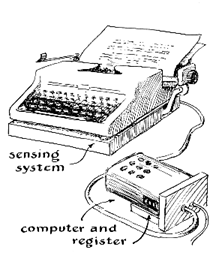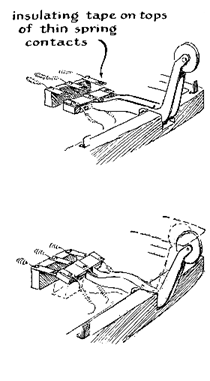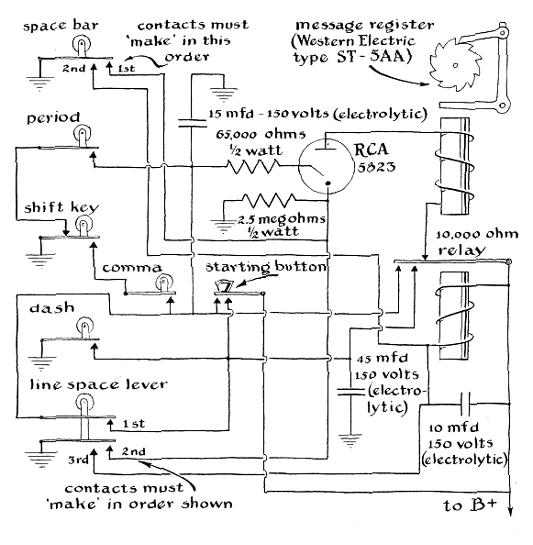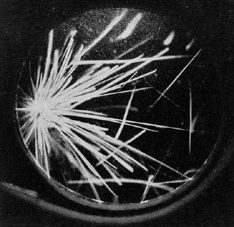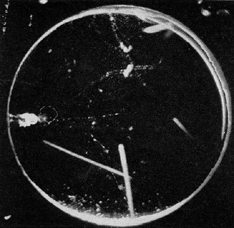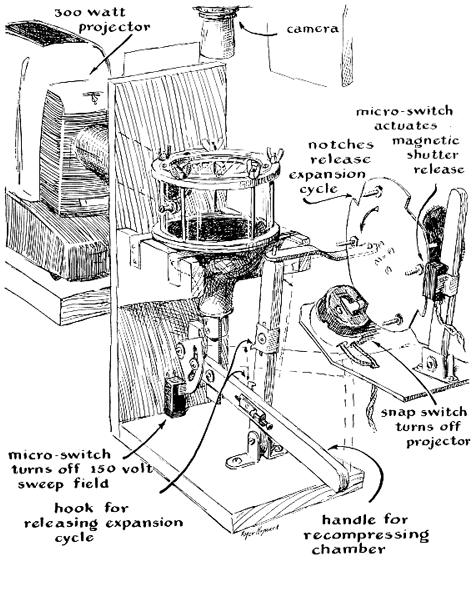A Computer to Solve a Problem of Mechanical Translation and an Ingenious Cloud Chambers
---------------------
by C. L. Stong
December, 1956
---------------------
![]() IN
MARCH, 1955, THIS DEPARTMENT
described several electrical switching systems for playing games against
human opponents and solving puzzles. All were essentially simplified versions
of circuits commonly used in digital computers for expressing logical
relationships between the terms of a problem. Jules O'Shea, a student
at Ecole Polytechnique in Montreal, now submits a complete machine-one
equipped not only with logic circuits but with sensing elements for accepting
raw information, memory units for storing it, a "brain" for processing
the data and an output register for transforming the final electrical
pulses into Arabic numerals. He calls s machine a "Grammatical Word Computer,"
and he managed to build it for less than $15.
IN
MARCH, 1955, THIS DEPARTMENT
described several electrical switching systems for playing games against
human opponents and solving puzzles. All were essentially simplified versions
of circuits commonly used in digital computers for expressing logical
relationships between the terms of a problem. Jules O'Shea, a student
at Ecole Polytechnique in Montreal, now submits a complete machine-one
equipped not only with logic circuits but with sensing elements for accepting
raw information, memory units for storing it, a "brain" for processing
the data and an output register for transforming the final electrical
pulses into Arabic numerals. He calls s machine a "Grammatical Word Computer,"
and he managed to build it for less than $15.
"As 'thinking' machines go," writes Shea, "my special-purpose computer stands pretty low on the I.Q. scale. It has just enough of a 'brain' to count words as they are written on a typewriter. The project was suggested by the article, 'Translation by Machine,' which appeared in the January, 1956, issue of SCIENTIFIC AMERICAN. A translating machine, the author pointed out, must first of all be capable of recognizing a word when one is presented for translation and of keeping track of sequences words. In short, it must count and record dissimilar entities occurring at random without apparent logical or mathematical relationship. The pronoun 'I' must count as heavily as the noun 'antidisestablishmentarianism,' and the machine may draw no distinction been a simple word such as 'cat' and a compound one such as 'brother-in-law.'
"At first glance the problem looks easy. Why not solve it simply by counting the spaces invariably left between words? The space bar of a typewriter would be fitted with a mechanical device which would register a count for each space and, hence, for each word. This obvious solution is ruled out by several difficulties, including the fact that there is no space after a sentence ending a line and that a word may be broken by a hyphen at the end of a line. Punctuation also introduces some problems: for instance, a comma usually ends a word, but it may also come within a set of digits making a number.
"In addition, there are certain limitations imposed by the typewriter itself. In my case, for example, the proposed computer was to be associated with a portable typewriter used daily both at school and at home. The computer could not be permitted to impair either the operation or portability of the machine. Moreover, I did not wish to mar the appearance of the typewriter by drilling holes in it or cluttering the frame with switches or other electrical parts. This requirement was finally met but at some cost, under certain circumstances, to the accuracy of the count of words.
"The computer I have designed for the purpose is a separate machine housed in two units. One holds the sensing elements and logic circuits; the other houses the memories, 'brain,' output register and power supply. The sensing elements are electrical switches, actuated mechanically by the typewriter keys. The switches are assembled in an inch-high rectangular box which serves as a base for the typewriter [see Figure 1]. The homemade switch arms are L-shaped pieces of plywood hinged at the outer end of the L's horizontal arm, which also carries contacts of strip copper. The upper end of each L touches the bottom of the appropriate typewriter-key lever. The compromise with the accuracy of count was made in the case of the linespace lever. Ideally the line-space lever and its switch would be linked directly. Instead I arranged for the carriage, when extended, to bear against a roller carried at the end of one oversized L. Thus the carriage, not the line-space lever, actuates the switch. The contact arrangement of this switch is such that a single impulse is transmitted when, and only when, the carriage is returned to the beginning of a line. The electrical circuit is completed when the movable contacts wipe across the fixed contacts in one direction. The opposite face of the movable contacts is insulated by a layer of friction tape. Hence no connection is made during the return wipe [see Figure 2]. All switches are wired to a multiprong receptacle mounted in the rear wall of the shallow box. Connection with the computer unit is made through a multiprong plug and cable.
"When amateurs first became interested in building complex switching systems, good relays could be picked up inexpensively on the
surplus market, and most early computers were designed around them. That source is now largely exhausted. So my design is based on electronic components. These have proved not only cheaper than relays but more effective and far more interesting. Electrolytic capacitors serve as memory units. I could find no reference in the literature to such an application of electrolytic capacitors in commercial computers. Conventionally they are equipped with magnetic components such as recording tapes, ferrite cores and so on. But I took a chance on capacitors because they are inexpensive and available in all radio supply stores.
"The brain of the machine consists of a single 'neuron'-an RCA-5823 gas triode. The mechanical structure of this tube resembles that of a conventional high-vacuum triode, but its operating characteristics are different. In a high-vacuum triode the flow of current between the plate and cathode can be minutely controlled by varying the charge on the grid. The gas triode, on the other hand, is an all-or-nothing device. When its grid is at zero potential with respect to the cathode, substantially no current can flow in the plate-cathode circuit if the plate voltage is below a critical value-about 200 volts in the case of the RCA-5823-at which the gas in the tube becomes ionized. But if a positive charge of about 75 volts is placed on the grid, it initiates a self-sustaining ionization of the gas, and current starts to flow in the plate-cathode circuit. It will continue to flow until the potential across the plate-cathode terminals is interrupted-even though the charge on the grid is reduced to zero. In other words, the grid loses control the instant conduction is initiated in the plate-cathode circuit. Like a neuron, the gas-filled triode either fires or refuses to fire, depending upon the state of charge on the grid.
"A message register of the type used in telephone central offices to meter calls serves as the output mechanism of the computer. It consists of a modified and elaborated relay in which the armature actuates a wheel-type counter through a ratchet. The energizing coil is wired in series with the plate-cathode circuit of the gas triode [see diagram in Figure 3]. Whenever the tube fires, a count is registered.
"The circuit includes a starting button to charge the memory capacitors beforehand and a slow-release relay for restoring the charge in the capacitors automatically according to the requirements of the text as typing on the typewriter proceeds. The memory capacitors are wired to the grid of the triode. The tube either fires or does not fire, depending upon the information present in the memories as represented by the state of their charge.
"To put the computer into operation, the typist presses the button, then writes the first word and hits the space bar. The first of two sets of contacts of the switch beneath the space bar closes, grounding the cathode of the triode and sending a pulse through the register for a count. The second set of contacts then closes, energizing the relay. The armature moves down and breaks the set of contacts between the register and power supply. Since the plate derives power through the coil of the register, the tube is extinguished automatically. 'Make' contacts of the armature then close, re storing both of the capacitors to full charge.
"The end of a sentence is customarily followed by two spaces, but the computer must register only one count for the last word in the sentence. When the typist hits the period key, this closes a set of contacts on the switch actuated by the period key-lever and discharges the 15-microfarad capacitor to ground. The absence of charge represents the information that a period has been inserted. The grid of the triode is at zero potential and the tube is immobilized. Accordingly, when the space bar is depressed no count registers. The second set of contacts on the space-bar switch energizes the relay, which restores the capacitors to full charge in readiness for the succeeding operation of the space bar. Thus in effect the computer remembers that it should not register a count following a period until the second of two spaces has been inserted.
"Different makes of typewriters m have their punctuation marks in different positions on the keyboard. On my machine, a Royal portable, the question mark appears in the upper-case position on the comma key. This means that the question mark is distinguished from the comma by the fact that this key and the shift key are pressed down simultaneously. My computer recognizes the event by means of a connection in series between the 'make' contacts of both keys, so that the capacitor is discharged when the two keys are operated simultaneously. When they are so operated, the action of the circuit is identical with that of the period-key circuit, and the computer registers only one count after the question mark just as it does after the period. The shift key is equipped with a second contact of the 'break' type through which the switch arm of the period key reaches ground. Hence operation of the shift key automatically inhibits the action of the period key.
"For the situations in which the end of a sentence comes at the end of a line or a word is split by a hyphen and carried over to the next line, the computer has a second memory. This is a capacitor of 45 microfarads; that is, it can store three times as much charge as the first one. A set of 'make' contacts on the linespace lever connects the two memories. The ratio of capacity of the two memories is such that the shared charge will not drop below 75 volts when the fully charged second capacitor is connected with the discharged first capacitor. But in the reverse case, when the first capacitor, in the fully charged state, is connected with the second in the discharged state, the potential of the combination drops below the critical value and immobilizes the tube. Now let us see what happens when a period comes at the end of a line. The striking of the period key discharges the small capacitor, thereby informing the memory that two spaces must precede the next count. At the same time the first of the sets of contacts on the switch of the line-space lever closes. The large capacitor discharges into the smaller one, restoring the critical potential. Thus the large capacitor remembers the exception and, in effect, instructs the brain to ignore the previous order. The second set of contacts on the line-space switch then closes the plate-cathode circuit for a count. Finally a third set of contacts on the line-space switch energizes the relay, restoring both capacitors to full charge and in effect wiping out all information in preparation for the next event.
"The insertion of a hyphen at the end of a line closes a set of contacts associated with the hyphen key. This discharges the large capacitor. The succeeding operation of the line-space lever then connects the two capacitors. The small capacitor shares its charge with the large one, but the shared potential is below the critical value. The brain is thus informed that the line ended with a broken word. Consequently no count is registered when the second set of contacts on the line-space switch closes.
"The machine thus provides for every variation of spacing and punctuation encountered in ordinary English text. To do so it must remember only two 'bits' of information at a time. These are represented by any two of three possible capacitor states-fully charged, discharged or shared charges.
"The accuracy of the count is subject to three limitations of the equipment. If the typist lets the carriage stand idle for more than five minutes at the end of a line terminated by a period, the capacitors discharge through leakage. Operation of the line-space lever will then fail to register a count. The error can be avoided by pushing the 'start' button. Errors also occur if the machine is operated at more than about 50 words per minute: inertia then prevents the register from following accurately. The solution, of course, is a high-speed register. At high speed the contacts of my homemade switches tend to operate simultaneously instead of sequentially. Commercial microswitches appear to be the cure.
|
|
"In spite of its imperfections, my machine has supported the design theory, and since I am only a hunt-and-peck typist, the slowness of the apparatus gives me no trouble. I get as much fun out of it as if it were able to count 100 words per minute.
"The capacitors, brain assembly, register and power supply are mounted on a common chassis enclosed by a container made from a liquid-floor-wax can which measures only two inches wide, four inches deep and eight inches long. The power supply is of the conventional voltage doubler type. It operates from 110 volts a.c. and is designed around a 117Z6 twin diode, the circuit of which is described in standard reference texts. The 10,000-ohm relay is of the type used for controlling the heat of electric blankets. I converted it for slow release by connecting a 10-microfarad capacitor during times when the tube is conducting. The 2.5-megohm resistor between the cathode and the ground stabilizes the action of the tube.
"Incidentally, the computer holds to arbitrary and stubborn opinions, as might be expected of a device with limited intelligence. Some authorities insist, for example, that an abbreviation should not be considered a word. Others disagree. The computer stoutly sides with the latter."
Among readers who requested the samples of radium offered last April in connection with the article on cloud chambers was Louie R. Hull, a physics teacher at South Side High School in Fort Wayne, Ind. He sends some photographs of alpha and beta tracks recorded in his homemade cloud chamber, one of which shows how a barrier of cellophane blocks the alpha particles [see photographs in Figures 4 and 5 ].
|
|
"These tracks," says Hull, "were photographed with the aid of a 'plumber's friend' cloud chamber-an arrangement assembled from odd parts from the junk box. Like the 'peanut-butter jar' chamber that you described, the plumber's friend can be constructed in a single evening. The basic idea stemmed from a chamber of the rubber-bulb compression type popular for classroom demonstrations. Although the rubber-bulb instrument is satisfactory for a visual demonstration, trouble was encountered when we attempted to photograph tracks with it. Compressions could not be reproduced uniformly, nor could we time the exposures correctly. Various alternate arrangements were tried until it occurred to us that the plumber's friend- a rubber plunger of the kind used for clearing drains-might work. In the cloud chamber it does not operate strictly as a piston does, of course, because the center of the plunger moves a greater distance than the edges. As a result the particle tracks are distorted somewhat; nevertheless we are delighted with the performance of the arrangement and have made hundreds of excellent pictures.
"The side walls of the chamber are cut from a quart glass jar by the hotwire method. You wrap a single turn of iron wire (such as that
used for binding brooms) around the jar tightly at the place where the cut is desired, the ends being separated by a small sheet of asbestos insulation where they would otherwise make electrical contact. The loop becomes red hot when you connect it across the six-volt terminals of a transformer or storage battery. After about 30 seconds of heating you remove the wire. Plunge the jar into cold water immediately. The glass will break cleanly at the line where it was heated by the wire. The sharp edges are then rounded with abrasive such as emery or carborundum.
"The top of the chamber is closed by a plate-glass window [see Figure 6]. If you do not own a circular glass cutter, one can easily be rigged from a wheel-type cutter available in hardware stores. Fasten the wheel end of the cutter to one end of a short length of inch-square wood so that the wheel protrudes slightly beneath the lower edge of the wood. Next drive a wood screw through the wood vertically at a distance from the cutter wheel equal to the radius of the desired glass disk. The protruding tip of the wood screw serves as the center point of a compass, the wheel as the other point. Then make an indentation with a center punch in a small scrap of 16-gauge sheet metal. You place this punched piece of metal on the glass to be cut, backing the metal with friction tape to prevent it from slipping. The punched indentation is centered with respect to the glass. Now you put the protruding tip of the wood screw in the indentation and make a circular cut in the glass with a single, firm rotary stroke of the tool. After this, if you make 10 straight radial cuts from this disk to the edge of the glass sheet, you can break away the outer pieces, leaving a disk the same size as the circular cut. You then smooth the edge of the disk with abrasive.
"The glass cylinder, window and plumber's friend are fastened together with metal rings [see drawing below]. The ring fittings can be built of thin sections cut from sheet metal and soldered. If a metal cutting lathe is available, you can machine them from a thick slab of stock. Rubber gaskets must be inserted where the metal and glass come into contact. Turbulence in the chamber is minimized by inserting a disk of black velveteen, supported by wire screening, between the cavity of the rubber plunger and the chamber. The radioactive sample is supported inside the chamber by a machine screw inserted through the side wall.
"The assembled chamber is supported on a wooden bracket. Its expansion is actuated by a lever mechanism, which is tripped by a motor-driven cam. The chamber is illuminated by a 300-watt slide projector, the beam of which is controlled by a shutter released electromagnetically. The camera is positioned above.
"To make the compression stroke you lift the horizontal lever quickly and hook it to the vertical lever [see Figure 6]. The compression should not exceed about one third of an atmosphere, or the chamber will fill with fog on expansion. After about 30 seconds you start the motor. The cam advances until the metal arm at the top of the vertical lever drops into a notch on the cam. A spring then pulls the vertical lever away from the chamber, unhooking the horizontal lever. The plumber's friend then springs to its original shape, accomplishing the expansion stroke.
"An electrostatic 'clearing' field is applied to the chamber automatically during the compression stroke by a microswitch actuated by
the horizontal lever. The field is removed by the switch and the leads to the chamber are short-circuited automatically at the end of the expansion stroke. Similarly, the motor-driven cam is equipped with switches for operating the projector and shutter release in sequence. Exposure time is fixed by the tension of a rubber band hooked to the shutter [drawing at lower left].
"The proportion and amount of liquid in the chamber are not critical. Good tracks form with either 180-proof grain alcohol or rubbing alcohol as it comes from the bottle. Performance is influenced by room temperature, however. Above 70 degrees Fahrenheit results are improved by diluting the alcohol slightly with water-say 15 drops of alcohol to two drops of water. It should be kept in mind that fog results from too much liquid as well as from over-expansion. The chamber rarely requires more than 20 drops of liquid. Don't expect to see tracks during the first few expansions. The liquid must have time to evaporate.
"Beta tracks, being thin, are more difficult to see than alphas and appear best when the alphas have faded. It is interesting to investigate the penetrating power of particles through thin sheets of various materials. The chamber also enables you to experiment with various other atomic phenomena. If you substitute a freshly polished needle of zinc for the radium source, for example, you will see beta tracks shoot from the point These are photoelectrons released b light shining on the metal. The number of photoelectrons ejected will increase immensely if the chamber is illuminate by an arc lamp shining through a window of sheet quartz or of a clear plastic that transmits ultraviolet light readily. Such modifications of the chamber enable you to investigate the photoelectric properties of many substances a well as other forces that disturb the atomic structure of matter."
Bibliography
THE DESIGN OF SWITCHING CIRCUITS. William Keister, Alistair E. Ritchie and Seth H. Washburn. D. Van Nostrand Company, Inc., 1951.
Suppliers and Organizations
Fry's Electronics retails over 30,000 electronic items within each store. Fry's has been keeping hi-tech professionals supplied with products representing the latest technology trends and advances in the personal computer marketplace for 15 years. Fry's has become the place where a technical customer can shop with confidence and comfort.
The Society for Amateur Scientists (SAS) is a nonprofit research and educational organization dedicated to helping people enrich their lives by following their passion to take part in scientific adventures of all kinds.
The Society for Amateur Scientists
5600 Post Road, #114-341
East Greenwich, RI 02818
Phone: 1-877-527-0382 voice/fax
Internet: http://www.sas.org/
